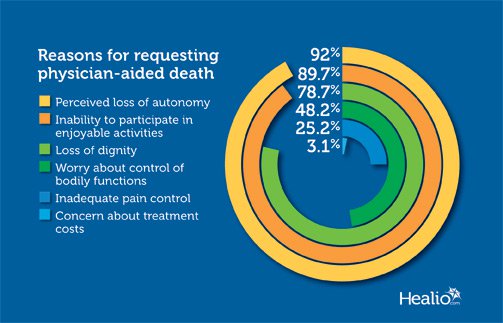Physician-aided deaths continue to rise in Oregon
The number of prescriptions written for physician-aided deaths in Oregon has increased annually since it became the first state to enact the Death with Dignity Act in 1997, according to a retrospective cohort study published in JAMA Oncology.
Of the 991 patients (51.4% men; median age, 71 years; range 25-102) in Oregon who used lethal self-medication from 1998 through 2015, 77% had cancer.

“Patients clearly want this option and increasingly use it when it is available,” Charles Blanke, MD, chairman of SWOG, professor of medicine at Knight Cancer Institute of Oregon Health & Science University, and a HemOnc Today Editorial Board member, told HemOnc Today. “However, having only an oral option makes it much more difficult for patients in a variety of ways.”
Physician-aided dying allows a physician to provide a terminally ill patient with a prescription for a lethal dose of medication that the patient intends to use to end his or her own life. In addition to Oregon, five other states — Washington (2008), Montana (2009), Vermont (2013), California (2015) and Colorado (2016) — and Washington, D.C. (2016) have enacted the Death with Dignity Act.
All physician-aided dying candidates in Oregon must be Oregon residents, certified by two physicians to have a life expectancy of less than 6 months, prescribed medication by a physician licensed in Oregon, capable of making and communicating health care decisions for themselves, and able to self-administer the medication. Patients also are told at several points after requesting physician-aided death that they may rescind their requests.
Of the 1,545 physician-aided dying prescriptions written in Oregon from 1998 through 2015, 991 patients (64%) ingested the medication and subsequently died. Six patients awakened after taking medication for an efficacy rate of 99.4%.
“Several aspects of the study are important,” Blanke said. “First, the medicines are extraordinarily effective, with very few unintended side effects. If a patient takes the lethal medication, he or she has a 99.4% chance of dying as a result. Also, [some] patients do not take the medication prescribed. Nonetheless, having the prescription still benefits the patient in terms of having control over his or her life or death. And, it does not appear the physician-aided dying is being forced upon the disadvantaged.”
From 1998 through 2015, physician-aided dying prescriptions in Oregon increased annually by an average of 12.1%, with more significant increases in later years — 28% in 2014 and 41% in 2015. In all, 336 physicians wrote an average of 3.4 (range, 1-71) physician-aided dying prescriptions.
Of the patients who used lethal self-medication, 52 (5.3%) were referred to psychiatrists for determination of competence, 46 (4.7%) were in long-term care facilities, and one was a hospital inpatient.
Physicians were present at the time of ingestion in 148 cases (16.1%). Most patients (93.5%) notified families of their intentions, and 94% of patients died at home.
Pure pentobarbital was a commonly used lethal drug until it became unavailable in 2012. More than half of the deaths (58.5%) resulted from secobarbital.
Median time to coma was 4 minutes (range, 1-38) and median time to death was 25 minutes, with a range of 1 minute to more than 4 days. Few unexpected toxic effects occurred; 24 patients (2.4%) experienced vomiting.
Cancer was the most common underlying terminal illness among those who used lethal self-medication. The most prevalent cancer sites were lung (17.9%), breast (7.4%), pancreas (6.4%) and colon (6.2%). Other terminal illnesses included amyotrophic lateral sclerosis (8%), incurable lung disease (4.5%) and heart disease (2.6%).
Most patients (92.2%) who elected physician-aided dying were enrolled in hospice and had health insurance, and 70.8% had at least some college education.
Patients reported a variety of reasons for requesting physician-aided dying: perceived loss of autonomy (92%), inability to participate in enjoyable activities (89.7%); loss of dignity (78.7%); worry about control of bodily functions (48.2%); inadequate pain control (25.2%) and concern about treatment costs (3.1%).
The study left researchers with many unanswered questions, Blanke said. Future research should capture more information on patients, such as how many have an underlying diagnosis of depression, whether tumors are primary or recurrent, and how long after diagnosis physician-aided dying prescriptions are written.
“Why do some patients go into prolonged coma before dying, and can we figure out who they are?” Blanke said. “Can we better palliate end-of-life concerns that seem to be more spiritual and emotional than medical? And how do we best develop new lethal regimens? We believe physician-aided dying is a promising area for formal, prospective research and would be of great interest in guiding cancer care delivery.” – by Chuck Gormley
For more information:
Charles Blanke, MD, can be reached at 2611 SW 3rd Ave., MQ280, Portland, OR 97201; email: blankec@ohsu.edu.
Disclosure: The researchers report no relevant financial disclosures.

